Money trees (Pachira aquatica) are surprisingly easy to care for and grow. In this article, I’ll show you all you need to know to keep yours thriving for decades.
Known for their braided trunks, and delicate looking umbrella-shaped leaves, money tree plants are very popular. They look like they’d be fussy and difficult to grow, but they’re actually pretty easy.
These lovely plants flourish with the proper care, and can grow to become large trees. They’re a great choice for beginners and experts alike.
Plus, if you want to try your hand at bonsai, Pachira aquatica is the perfect specimen to start with. In this detailed growing guide, I will tell you all about how to care for a money tree plant.
Money Tree Quick Care Overview
| Scientific name: | Pachira aquatica |
| Classification: | Tropical plant |
| Common names: | Money Tree, Malabar Chestnut, Guiana Chestnut |
| Hardiness: | Zones 10+ |
| Temperature: | 60-85°F |
| Flowers: | White, blooms in later winter / early spring |
| Light: | Partial shade, bright light indoors |
| Water: | Keep soil evenly moist, do not overwater |
| Humidity: | Average to high |
| Fertilizer: | General purpose plant food spring-summer |
| Soil: | Fast-draining, fertile soil |
| Common pests: | Whiteflies, aphids, spider mites |
Information About Money Tree Plants
The money tree (Pachira aquatica) is a very popular plant that’s native to South and Central America.
Though it’s most commonly kept indoors, it’s actually a tropical tree that can grow outside year-round in the warmer climates.
In their native habitat they can get as tall as 15′, and grow very fast. But in a container or inside, they usually stay between 7-10′.
Other Types Of Money Plants
People often call this a “money plant”. But there are a few different plants that have that same common name. So before we go any further, let’s make sure that you and I are talking about the same one here.
This article is all about how to care for a money tree (Pachira aquatica). If you’re looking for information on a different plant, then check out the list below. Otherwise, keep reading!
- Chinese Money Plant (Pilea peperomioides)
- Jade Plant (Crassula)
- Pothos Plant (Epipremnum aureum), aka Devil’s Ivy
Pachira Money Tree Plant Meaning
No, money trees don’t grow actual currency (wouldn’t that be nice!), but there is meaning behind the name.
Pachira aquatica got its common nickname because they have a reputation for bringing luck and good fortune to their owners. This is one of the main reasons why I think they are the perfect office plant!
Maybe you’ve never heard the name, but you might recognize a money tree because it’s one of the most popular braided trunk plants.
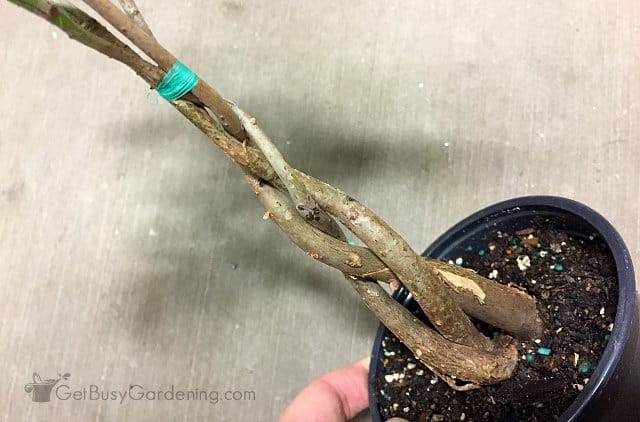
Benefits Of Money Tree Plants
So what is money tree plant good for? Well, as I already mentioned, the benefits include bringing you good luck and financial prosperity.
They are also very popular in Feng Shui, because they are said to bring positive energy into the room where they’re growing. They’re commonly given as gifts for all of these reasons.
I’m not sure how they got such an amazing reputation, but I’m thinking about growing a lucky money tree plant in every room of my house!
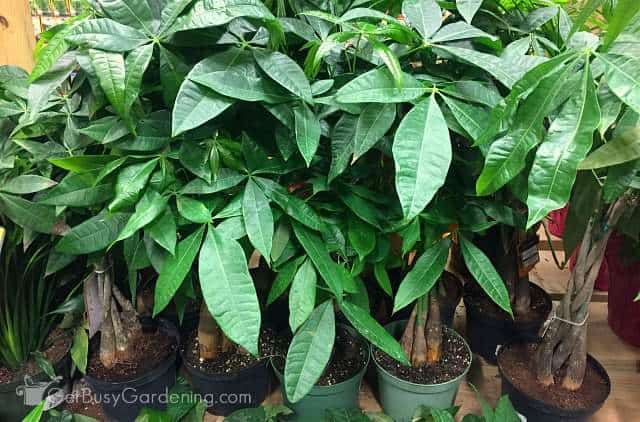
Pachira aquatica Flowers & Fruits
You might be surprised to learn that, when given the proper care, a money tree can bloom and produce edible fruits and seeds.
The highly fragrant flowers open at night, and only last through the next morning or early afternoon before they fade and drop off. They are big, cream or white in color, and can have long red/pink stamens.
If pollinated they will produce a fruit that looks like a cocoa or large nut, hence the common names Malabar or Guiana chestnut.
Both the fruits and the seeds are edible, and can be eaten raw or roasted. The seeds can also be planted to grow new money trees. It’s extremely rare for them to bloom and set fruit indoors though.
Where To Grow Money Trees
Most people grow their money tree indoors year round, but they can also do very well outside in warmer climates. They are hardy in zones 10+.
You can either plant them in the ground, or put them in a pot if you want to restrict their size. Just be sure it has drainage holes so your tree won’t drown when it rains.
Once you choose the perfect spot, it’s best to leave them there. They don’t like to be moved, so if they’re not hardy where you live, keep them inside year round rather than putting them outdoors for summer.
Pachira Money Tree Care & Growing Instructions
Though they are pretty easy to grow, they do have some fairly specific requirements that need to be met in order to thrive. Follow these money tree plant care instructions for the best results.
Watering A Money Tree Plant
One of the key factors to successful money tree care is proper watering. They like a lot of water, but won’t tolerate wet feet for very long. Too much can cause root and stem rot.
Avoid letting them dry out completely though. Instead water when the top 2-3” of soil is dry. A moisture gauge can be helpful in getting it just right.
When it’s time, give it a good drink, and let the excess drain from the holes in the bottom of the pot. Dump the drip tray right away so it’s never soaking.
Humidity Requirements
Another important part of successful money tree care is humidity, which is especially critical indoors during the winter months.
Dry air causes the leaves to curl and turn yellow or brown before dropping off. To increase it, try running a humidifier nearby, or put the plant on a pebble tray.
Misting can also work, though don’t let too much moisture sit on the leaves. To help you maintain the proper humidity level, keep an indoor air moisture monitor nearby.
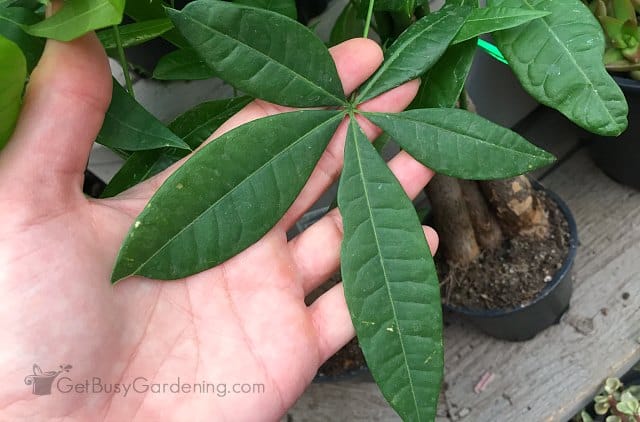
Money Tree Light Requirements
One of the reasons growing money trees indoors is so easy is because they aren’t super picky about lighting.
They prefer bright, indirect sunlight. But they will adapt to lower light conditions indoors, especially during the winter. If yours is getting leggy or reaching for the window, add a grow light.
Outdoors, money trees can grow anywhere from full to partial sun. But in arid climates they will do best with more shade to prevent burning.
Temperature
Though Pachira aquatica can tolerate cooler temperatures, they grow best when it stays between 60-85°F.
They can survive brief periods below freezing, but will start to suffer when it’s that cold for more than a few hours.
Warmer temps won’t bother them, as long as you give them extra protection from the intense afternoon sun.
Repotting Your Money Tree
Since they grow so fast, you should plan to repot your money tree every few years as a part of their regular care routine. The best time to do it is spring or early summer.
When the time comes, make sure you choose the right sized container. Don’t use one that is too large, because that can cause issues with overwatering and root rot.
Money trees can be grown in very small pots, especially if you want to keep their size manageable. So choose a one that’s only slightly larger than the original.
Related Post: How To Repot Plants: A Helpful Illustrated Guide
Best Potting Soil For Money Tree Plant
A general purpose potting soil will work fine for growing money trees. But, they will do best in a fast draining mix that also retains moisture.
Try using a sandy one, then adding peat moss or vermiculite to help it retain moisture. If you don’t want to fuss with all of that, you can’t go wrong using a bonsai mix.
But you can learn all you need to know in my complete guide to the best type of soil here, and get my recipe to make your own too.
Best Fertilizer For Money Trees
Though money trees aren’t heavy feeders, they’ll benefit from it now and then. They can be sensitive to synthetic chemicals, so I recommend using organic products only.
You can feed them using a half-dose of liquid houseplant fertilizer or compost tea every couple of weeks during the spring and summer.
If you find it easier, try bonsai pellets instead of liquids. Stop fertilizing in late summer, and don’t feed them at all during the fall and winter months.
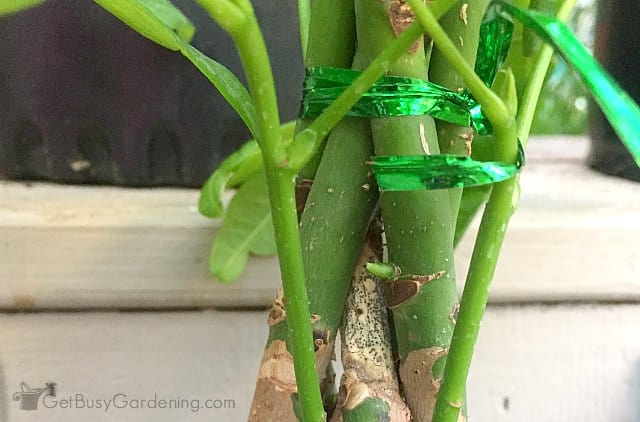
Pest Control
Insects aren’t normally an issue for healthy money tree plants, but whiteflies, spider mites, and aphids can sometimes invade. If you discover a bug infestation, begin treatment immediately.
Neem oil is my top choice for getting rid of bugs on the leaves. You can also try a pre-mixed insecticidal soap, or make your own with 1 tsp mild liquid soap per 1 liter of water.
Use a yellow sticky trap to capture and help control flying insects.
How To Prune A Money Tree
In general they don’t need to be trimmed, but regular pruning will keep your money tree plant smaller and more manageable. The best time is in the spring or summer.
To prune yours cut off the tips, which will encourage branching and make it fuller. Use bonsai shears or a micro-tip snip for precision cuts.
If it’s overly large, you can top the whole thing to control the size. New leaves grow back quickly, which is one reason why they are so appealing for bonsai.
You can learn exactly how to prune your money tree with my detailed guide and step by step instructions here.
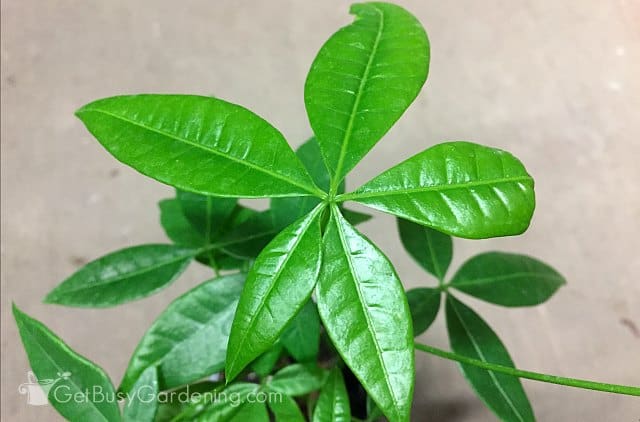
Money Tree Propagation Tips
The two main ways to propagate a money tree are either by stem cuttings or planting the seeds. Taking large cuttings is the fastest way to get a sizable tree.
Simply dust them with rooting hormone and put them into a damp medium until they start to grow. Get the full steps for how to propagate your money tree here.
Troubleshooting Money Tree Care Problems
Though they are fairly easy to grow, there are some common money tree care problems that people tend to have. Here’s how to troubleshoot the symptoms, and what to do about it.
Leaves Turning Yellow
Yellowing leaves usually means you’re watering too much, though it can also be from moving it around, or when it gets too cold for them.
Allow the soil to dry more between waterings, and ensure the temperature stays between 60-85°F. If you recently put it in a new location, then leave it alone because they hate being moved.

Leaves Turning Brown
Lack of humidity or water is usually what causes brown leaves. Raise the humidity level around the plant, and make sure it’s getting enough moisture.
They are also sensitive to sudden temperature changes, and can suffer when exposed to hot or cold drafts. So keep them away from heat vents and drafty areas.
Intense hot sunlight can burn them, so give them afternoon shade if you suspect that’s the problem.
Money Tree Dropping Leaves
Money trees are a bit fussy about their location, and don’t like to be moved around. If you move them too much, the leaves will start dropping.
So keep it where it is, and try not to move it. If you just brought it home, give it plenty of time to adjust.
Improper watering is also a common cause, so make sure the soil stays evenly moist, and never wet or bone dry.
Money Tree Not Growing
If your money tree is simply not growing, then it’s either too cold, improper watering, root or stem rot, or not enough light.
The first thing to do is check the soil to ensure it’s not soggy or wet, and that the stem is firm rather than soft or rotting.
If that’s not the problem, then give it plenty of warmth, and add a grow light if it’s too dark in your home.
FAQs
In this section I’ll answer some of the most frequently asked questions about money tree care. If you can’t find yours here, ask it in the comments below.
Is a money tree the same as Pachira aquatica?
Yes, a money tree is the same as Pachira aquatica. Money tree is the common name, and Pachira aquatica is the botanical or scientific name.
How fast does a money tree grow?
A money tree can grow very fast with the proper care. In the ideal environment, they can put on a few feet per year. It takes just 5-7 years for them to fully grow into a large tree.
Are money trees hard to take care of?
No, money trees are not hard to take care of, in fact they’re actually quite simple to grow. They’re very resilient and low maintenance, just requiring the basic light, water, humidity, and temperature.
Can A Money Tree Go Outside?
Yes, a money tree can go outside as long as the weather is warm enough, or you live in growing zones 10+. Otherwise, be sure you bring it back inside before the temperature gets below 50°F.
Is Pachira aquatica safe for cats and dogs?
Yes, Pachira aquatica is safe for cats and dogs – and humans too, for that matter. According to the ASPCA website, they are non-toxic to pets.
Growing money trees is fun, and their care is easier than you might think. I’m not sure if it will actually bring you all of the benefits that I mentioned above, but it can’t hurt to try.
If you want to learn all there is to know about maintaining healthy indoor plants, then you need my Houseplant Care eBook. It will show you everything you need to know about how to keep every plant in your home thriving. Download your copy now!
More About Different Houseplant Types
- How To Care For Sago Palm Trees (Cycas revoluta)
- How To Care For Rubber Plants: The Ultimate Guide
- How To Care For Umbrella Tree Plant (Schefflera arboricola)
- How To Care For Alocasia Plants
- How To Care For African Mask Plants
- How To Care For A Peace Lily Plant
- How To Care For Fiddle Leaf Fig Plant (Ficus lyrata)
Share your money tree care tips in the comments section below.

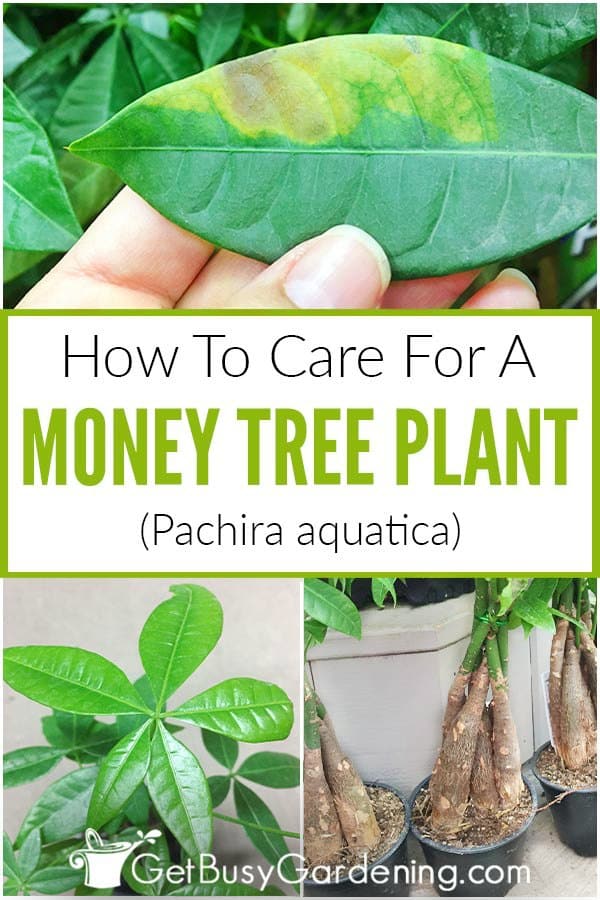
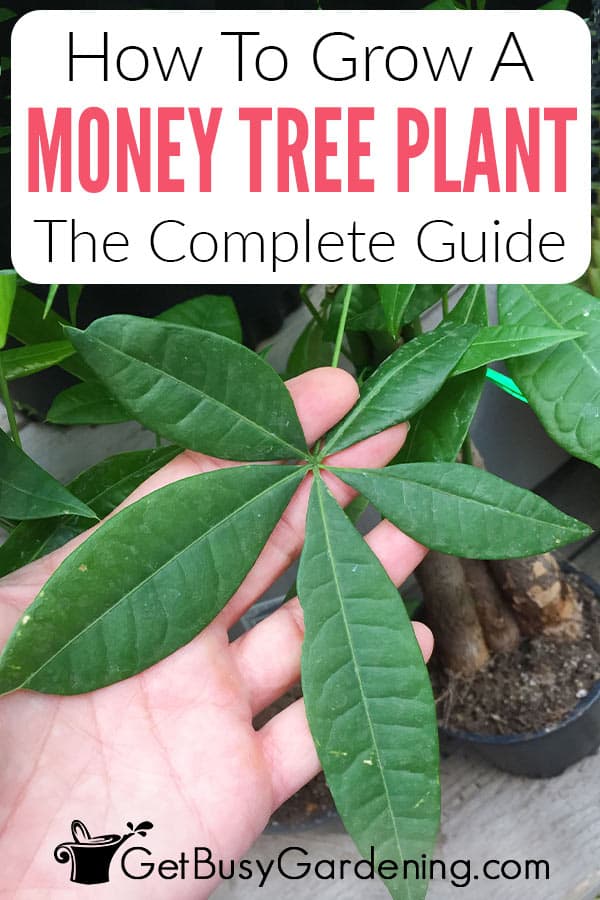


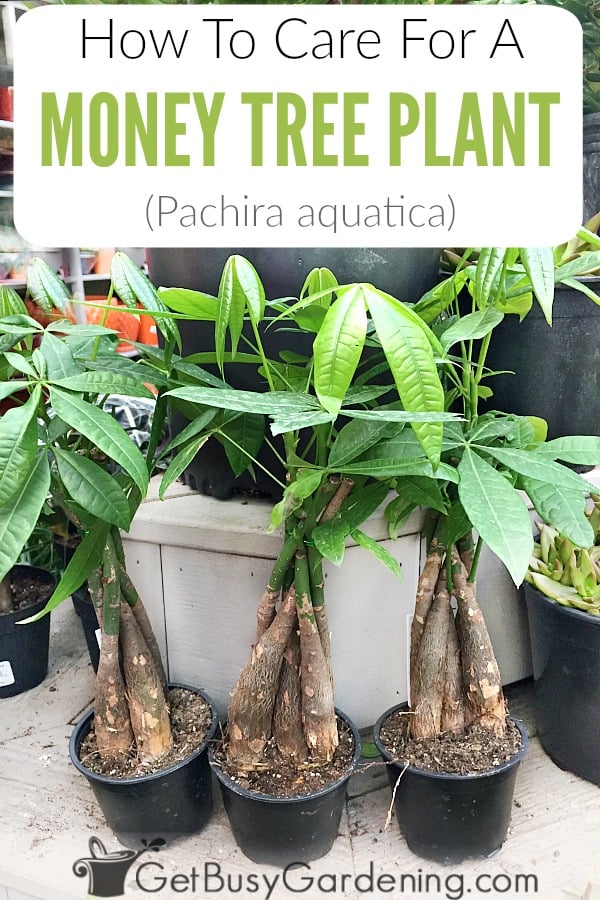
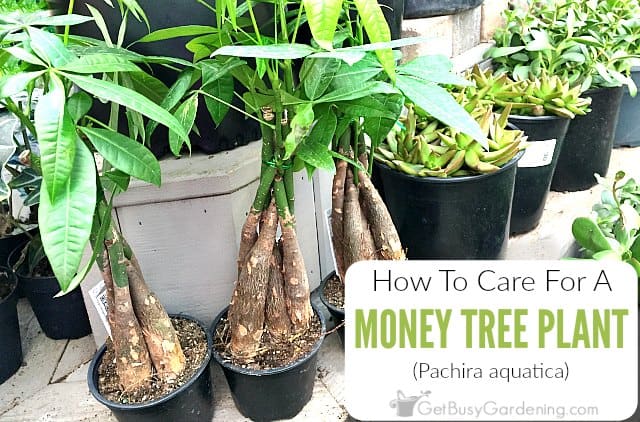


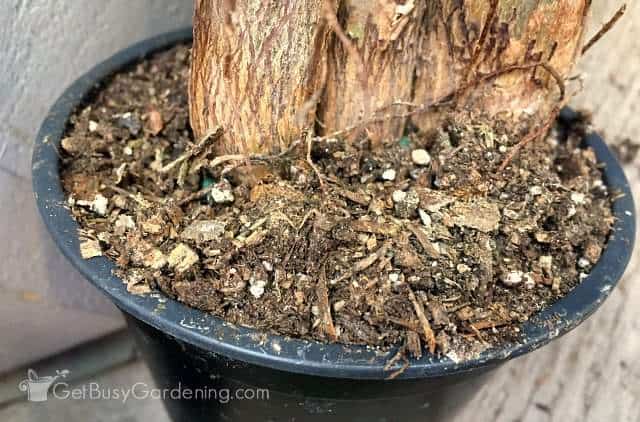


Charlotte Caines says
my granddaughter has a money tree and moving from SC to TN has left in my care. Unfortunately the leaves are turning yellow and dropping off and the stem is very loose in the soil. what should can I do ?
She will be retrieving the plant once settled.
Amy Andrychowicz says
When the leaves on a money tree plant turn yellow and start dropping, that usually means it’s being overwatered. To prevent that, allow the soil to dry out more between waterings. It should never bet wet or soggy. See the “Money Tree Watering” section above for more information.
Tammy says
I just purchased a money tree and when I got it home i noticed there are tiny brown dots on all the leaves. What should I do?
Amy Andrychowicz says
Oh no, that sounds like it could be houseplant scale on your brand new money plant. Here’s a post with lots of pictures to help you identify it, and show you how to get rid of it… How To Get Rid Of Scale Insects On Houseplants
If you do determine your money tree is infested with scale, I would think about returning it since you just bought it. Getting rid of scale is very difficult, and it’s not very nice that the place you bought it sold you a bug infested plant.
Anne Cook says
Can I twist the stalks a 2nd time?
Amy Andrychowicz says
If you mean can you keep braiding the trunks as they grow, then yes. As long as they are green and pliable, you can keep braiding money tree stems as they grow taller.
Lou says
Is it okay to trim a stalk back to the point where no leaves remain? Will it regrow? My tree is 6 feet tall and the leaves begin at 5 feet. Very leggy. If I cut back one stem at a time below where the leaves start, will this kill the plant? Having no leaves on a stem?
Amy Andrychowicz says
Yes, pruning back the leggy money tree branches will help the plant grow bushier. As you mentioned, you should absolutely do this in phases. You never want to remove all the leaves from the tree at once. Start by pruning back a few of the worst looking branches. Then, once the plant starts filling out in those areas, you can cut off a few more branches, and so on. Never trim it back to more than 1/2 its size at once though.
Marian says
How tall can a money tree grow?? I have 2 of them and i love them, also I’ve found 3 leaves with 7 leaves
How exciting
Amy Andrychowicz says
Money trees can grow to be up to 15′ tall. Sounds like yours are doing great. 🙂
Inge Morgenthaler says
I grew up in Fridley Minnesota. Now I live in California. I read about the money tree and not giving it too much water. A branch broke off and I place it in a little container With water and now it’s sprouting roots. Do I leave it in water or transplant it in soil.
Amy Andrychowicz says
Fantastic, congrats on rooting your money plant cutting! I would pot it up into soil.
Sololy says
Hello!
My money tree is currently in about a 10″ pot (I think it’s too big for it) and recently the leaves started falling, yellowing and wrinkling. One of the branches was completely empty when squeezed, so I cut off all the dead leaves – which left my money tree looking very thin, but I think it was a good decision. A few months ago, I noticed there little flies around my house and they seemed to have nested inside the money tree’s soil. I put a bunch of sticky pads around the money tree and I haven’t seen the flies since. I also haven’t moved my money tree, but there are some Christmas decorations around it now. Could the Christmas decorations be disturbing it? Or did I overwater? Should I repot my money tree to a smaller pot?
Amy Andrychowicz says
So sorry to hear that your money tree is struggling. The presence of gnats is a sure sign that you’re overwatering. They live and bred in wet soil. Always check the soil by sticking your finger one inch deep to see how damp it feels before adding more water. If it feels pretty wet, then wait. Be sure to follow my tips for watering above. Whatever you do, don’t repot it until it has recovered. Repotting a sick plant can end up being fatal, so I would just leave it in the large pot for now, and work to get the watering right and bring it back to health. Good luck!
Lindsay says
I had the most wonderful, healthy money tree that was loaded onto a moving truck and supposed to be kept in storage for 6 days. Something went wrong and it ended up being left outside in the heat for a month. I received it back with no leaves and just 5 twisted stems. I have repotted in indoor potting mix with peat moss mixed in. I cut back the stems until I found health. I only have hope for 2/5 stems. What are the chances of it growing again?
Amy Andrychowicz says
Oh no! Sorry to hear that your money tree went through that trauma! The best you can do is leave it alone and hope it will recover. Don’t move it, and definitely don’t repot it again. Just keep the soil evenly moist, but not wet during this time, and don’t fertilize it. Good luck!
Kathy Martin says
My money plant has done VERY well. It is huge. I can’t bring it back inside. I live in NC and the temps will get below 40 degrees. If I plant it in the ground outside will it die? I don’t know what to do. Thanks!
Amy Andrychowicz says
Great to hear your money tree is growing so well, that’s great! They are hardy down to zone 10 (maybe 9b), so I don’t think it would survive the winter outside in NC. You could top the tree, and/or give it a good pruning if that helps to get it back inside.
Gretchen says
My money tree is leaning very far to the right. I turned the pot hoping it would start to straighten up thinking it was growing toward the sunlight, but it hasn’t made a difference. Any suggestions?
Amy Andrychowicz says
If your money plant is leaning because it was growing towards the light, then it will take some time for it to start growing back the other way after rotating it. When a plant grows towards the window, that means it’s not getting enough light. I would either move it to a brighter location, or add a grow light. Also, if the entire plant is leaning (rather than just the top of it), then you could also try staking it up until it starts grow straight again.
Lex says
Actually pruning, breaking, cutting Money Trees are considered bad luck. Just let it grow as it meant to be or repot or move to another corner for room to grow… and never put money tree in your bedroom where you sleep or bathoom:(
Amy Andrychowicz says
Thanks for your input about keeping the money tree lucky! 🙂
Diana says
I purchased a moisture/ph/light meter. What are the levels that i should be looking at for the money tree?
Amy Andrychowicz says
For your money tree, let the meter get just to the point where it’s going from the “moist” to “dry” level. So, on my moisture gauge, that would be between 3 and 4.
Terry Bowdre says
Several years ago I gave a friend a money plant. It has since gotten very leggy following repotting an the ensuring leaf drop. I noticed today that the new growth has droplets of a sticky substance. I could not see any evidence of bugs or disease, so am wondering what might be causing this. I also suggested that he pinch out new growth at the tops of the branches to encourage a more bushy appearance.
Thanks in advance for your advice.
Terry
Amy Andrychowicz says
If you’re sure the money plant doesn’t have bugs (I would definitely check closely for scale or mealybugs, both of which leave behind a sticky residue!), then it could just be transpiration. Transpiration is normal and nothing to be concerned about.
Good advice about the pruning. He can also give it a good haircut in the spring to encourage new growth through the summer. I would also consider giving the plant more light if it continues to grow leggy like that.
John says
Help! I have purchased a few Money Tree’s in the past couple years and the same fate has come to them all. They thrive for a few months, seem stagnant for a few months and then begin to die! One at a time the “trunks” wither and the leaves dry up on that stem and drop until all the trunks (stems) are gone. I am using filtered water, water once every 7-10 days and fertilize lightly a few times a year. My last one began to go during a humid summer so i don’t think humidity has anything to do with it. Any idea’s?
Amy Andrychowicz says
Money trees like to dry out a bit between waterings. So, if you were automatically watering it every 7-10 days, then I suspect it may have been over watered. Always be sure to check the moisture level of the soil before watering to be sure the plant actually needs it. To check the moisture level, you can stick your finger one inch into the soil. If it’s damp then don’t water it. You could also get a soil moisture meter to help make it easier.
Irene Fairfield says
Hi Amy,
My money plant is doing well but I get sticky, clear, water like droplets on my leaves and stems. What could be causing this?
Amy Andrychowicz says
It could be transpiration, which is normal and nothing to be worried about. However, since you said it’s a sticky substance, it would be a good idea to check to make sure your money plant doesn’t have mealybugs or scale. When those types of bugs feed on plants, it can leave a sticky residue which many times is the first sign of infestation.
Lynne Morgan says
Can you put a money plant outside in a sheltered place in the Uk thanks
Amy Andrychowicz says
Money plants are only hardy to USDA z9b, and won’t survive outdoors in colder winters. I’m not sure what growing zone the UK would be, but I think it’s much lower than that.